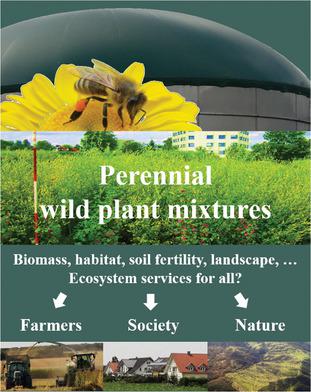当前位置:
X-MOL 学术
›
Adv. Sust. Syst.
›
论文详情
Our official English website, www.x-mol.net, welcomes your feedback! (Note: you will need to create a separate account there.)
Renewable Energy from Wildflowers—Perennial Wild Plant Mixtures as a Social‐Ecologically Sustainable Biomass Supply System
Advanced Sustainable Systems ( IF 7.1 ) Pub Date : 2020-05-13 , DOI: 10.1002/adsu.202000037 Moritz Cossel 1
Advanced Sustainable Systems ( IF 7.1 ) Pub Date : 2020-05-13 , DOI: 10.1002/adsu.202000037 Moritz Cossel 1
Affiliation

|
A growing bioeconomy requires increasing amounts of biomass from residues, wastes, and industrial crops for bio‐based products and bioenergy. There is much discussion about how industrial crop cultivation could promote social–ecological outcomes such as environmental protection, biodiversity conservation, climate change adaptation, food security, greenhouse gas mitigation, and landscape appearance. In Germany, maize (Zea mays L.) is the main biogas substrate source, despite being associated with problems such as erosion, biodiversity losses, an increase in wild boar populations and lowered landscape diversity. The cultivation of perennial wild plant mixtures (WPM) addresses many of these problems. Despite being less developed than maize, WPM cultivation has received notable attention among scientists in Germany over the past decade. This is mainly because WPMs clearly outperform maize in social–ecological measures, despite their methane yield performance. This review summarizes and discusses the results of 12 years of research and practice with WPMs as a social‐ecologically more benign bioenergy cropping system.
中文翻译:

野花产生的可再生能源-多年生野生植物混合物作为一种社会生态可持续的生物质供应系统
不断发展的生物经济要求越来越多的残留物,废物和工业作物产生的生物质能用于生物基产品和生物能源。关于工业作物种植如何促进社会生态成果的讨论很多,例如环境保护,生物多样性保护,气候变化适应,粮食安全,温室气体减排和景观。在德国,玉米(Zea maysL.)是主要的沼气底物来源,尽管存在诸如侵蚀,生物多样性丧失,野猪种群增加和景观多样性降低等问题。多年生野生植物混合物(WPM)的栽培解决了许多这些问题。尽管WPM的种植不及玉米,但在过去十年中,WPM的种植受到了德国科学家的关注。这主要是由于WPM在甲烷排放方面表现出色,但在社会生态措施方面明显优于玉米。这篇综述总结并讨论了WPM作为社会生态学上更加良性的生物能源种植系统12年研究与实践的结果。
更新日期:2020-07-07
中文翻译:

野花产生的可再生能源-多年生野生植物混合物作为一种社会生态可持续的生物质供应系统
不断发展的生物经济要求越来越多的残留物,废物和工业作物产生的生物质能用于生物基产品和生物能源。关于工业作物种植如何促进社会生态成果的讨论很多,例如环境保护,生物多样性保护,气候变化适应,粮食安全,温室气体减排和景观。在德国,玉米(Zea maysL.)是主要的沼气底物来源,尽管存在诸如侵蚀,生物多样性丧失,野猪种群增加和景观多样性降低等问题。多年生野生植物混合物(WPM)的栽培解决了许多这些问题。尽管WPM的种植不及玉米,但在过去十年中,WPM的种植受到了德国科学家的关注。这主要是由于WPM在甲烷排放方面表现出色,但在社会生态措施方面明显优于玉米。这篇综述总结并讨论了WPM作为社会生态学上更加良性的生物能源种植系统12年研究与实践的结果。



























 京公网安备 11010802027423号
京公网安备 11010802027423号